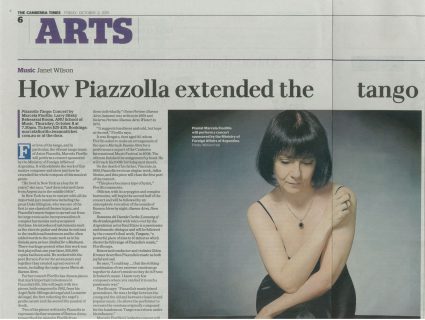How Piazzolla extended the tango
Source: The Canberra Times. October 1, 2015. By Janet Wilson
Piazzolla Tango - Concert by Marcela Fiorillo at the ANU School of Music
Piazzolla Tango: Concert by Marcela Fiorillo. Larry Sitsky Rehearsal Room, ANU School of Music. Thursday, October 8 at 7.30pm. Tickets $25-$35.
Bookings: marcelafiorillo.iwannaticket.com.au or at the door.
For love of the tango, and in particular, the vibrant tango music of Astor Piazzolla, Marcela Fiorillo will perform a concert sponsored by the Ministry of Foreign Affairs of Argentina. It will celebrate the work of this master composer and show just how he extended the whole compass of this musical genre.
"He lived in New York as a boy for 10 years," she says, "and then returned there from Argentina in the middle 1940s".
In New York he was in contact with all the important jazz musicians including the great Duke Ellington who was one of the first to use classical themes in jazz, and Piazzolla's music began to spread out from its tango roots as he incorporated into it complex harmonies and syncopated rhythms. He introduced instruments such as the electric guitar and drums in contrast to the traditional bandoneon and he often added words to the music such as in his Balada para un loco (Ballad for a Madman). There was huge protest when this work was first played but one year later 200,000 copies had been sold. He worked with the poet Horacio Ferrer for seven years and together they created a great oeuvre of music including the tango opera Maria de Buenos Aires.
For her concert Fiorillo has chosen pieces that mark important milestones in Piazzolla's life. She will begin with two pieces, both composed in 1962, from his Angel Suite: Milonga del angel and La muerte del angel, the first reflecting the angel's gentle nature and the second the passion of death.
Two of the pieces written by Piazzolla to represent the four seasons of Buenos Aires, transcribed for piano by Fiorillo from arrangements by Jose Bragato, will follow. "Piazzolla never composed these as a cycle," Fiorillo says, "and preferred to perform them individually." Otono Porteno (Buenos Aires Autumn) was written in 1969 and Invierno Porteno (Buenos Aires Winter) in 1970. "It suggests loneliness and cold, but hope at the end," Fiorillo says.
It was Bragato, then aged 92, whom Fiorillo asked to make an arrangement of the opera Maria de Buenos Aires for a performance as part of the Canberra International Music Festival in 2008. The old man finished the assignment by hand. He will reach his 100th birthday next month.
On the death of his father, Vincente, in 1959 Piazzolla wrote an elegiac work, Adios Nonino, and this piece will close the first part of the concert. "This piece became a type of hymn," Fiorillo comments.
Oblivion, with its arpeggios and complex harmonies will begin the second half of the concert and will be followed by an atmospheric evocation of the sounds of Buenos Aires by night: Buenos Aires, Hora Cero.
Romanza del Duende Curda (Lovesong of the drunken goblin) with voice over by the Argentinian actor Raul Rizzo is a passionate and dramatic dialogue and will be followed by the concert's final work, Tangata, "a powerful piece of 9 to 10 minutes which shows the full range of Piazzolla's music," Fiorillo says.
Renowned conductor and violinist Gidon Kremer describes Piazzolla's music as both joyful and sad. He says, "I could say ... that the striking combination of two extreme emotions go together in Astor's music as they do in Franz Schubert's music. I know very few composers where you can feel it in such a passionate way."
Fiorillo says, "Piazzolla's music joined generations. He was a bridge between the young and the old and between classical and popular music. He allows the performer to recreate the versions originally composed for the bandoneon. Tango was reborn under his influence."
Marcela Fiorillo's Canberra concert will be the first of a series which will tour to Kuala Lumpur and Bangkok and finish in Buenos Aires at the beginning of December.

